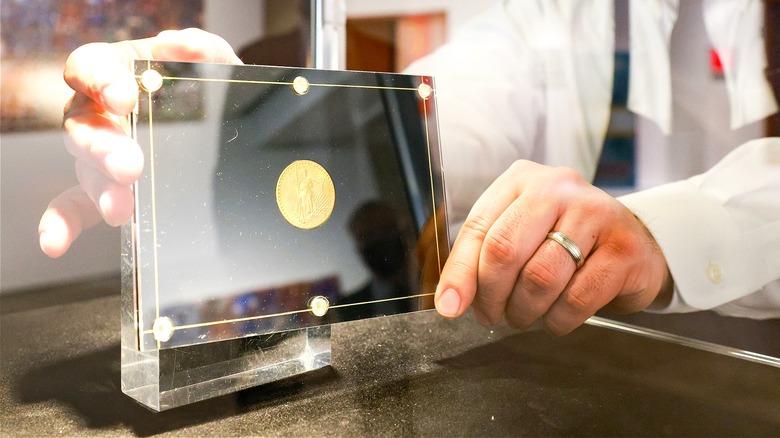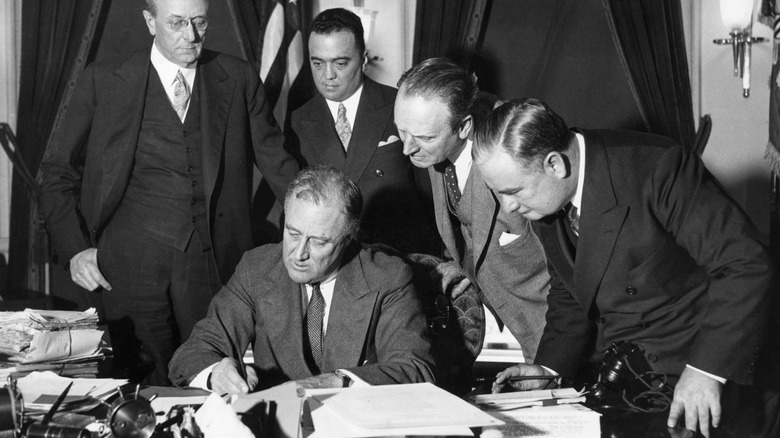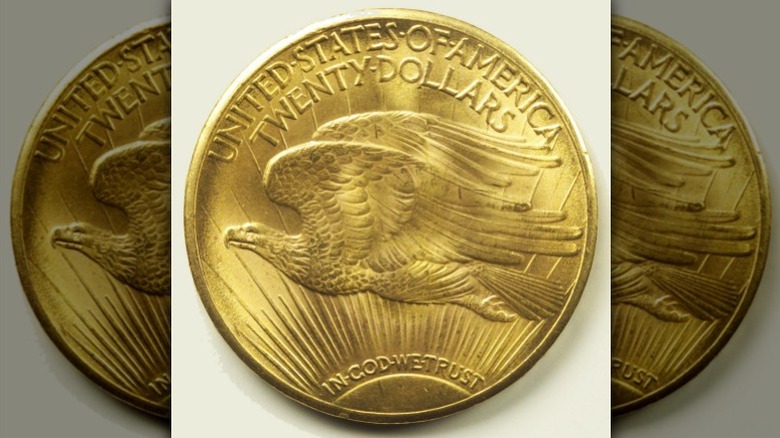The Unexpected Value Of The Rarest $20 Gold Coin
What if an entire treasure chest's worth of riches was contained in a single gold coin that could fit in the palm of your hand? Such a coin is not the stuff of hypotheticals, of course. It really exists, and it's also the only coin of its kind allowed to be legally owned. We're talking about the 1933 double eagle, the rarest $20 gold coin ever.
The 1933 double eagle coin is exceedingly rare, as well as the star of its own saga. After decades of art, intrigue, history-making, and scandal, this particular piece of shimmering gold now commands a price in the millions, a far cry from its original face value of $20. Its last auction price is even more impressive, considering this coin isn't even supposed to exist.
While the $20 double eagle never actually entered circulation as intended, and was long thought to have been melted down as part of President Franklin Delano Roosevelt's attempts to pull the country out of a period of gold-hoarding and depression, the single legal double eagle last sold at auction for $18.9 million, to a buyer who has chosen to remain nameless.
The double eagle's dramatic origin story
The 1933 double eagle features a torch-bearing Lady Liberty on the obverse (heads) side, and an eagle soaring through a sunrise on the reverse (tails).The beautiful design is the result of President Theodore Roosevelt lobbying renowned sculptor Augustus Saint-Gaudens to bring some razzle-dazzle to American coinage in 1905. To this day, Saint-Gaudens coins are highly collectible.
In 1933, Saint-Gaudens' design (with a few alterations) was struck by the Philadelphia Mint, with 445,000 gold double eagles in production. Yet, before the coins were released, a different Roosevelt influenced their fate. Franklin Roosevelt essentially outlawed privately owned monetary gold with the passage of the Gold Reserve Act of 1934. While FDR's gold program and suspension of the gold standard was highly controversial, the idea behind it was to stop gold-hoarding and to keep the economy from suffering further. If only FDR could foretell U.S. consumers buying gold bars at Costco, but we digress.
Under the Gold Reserve Act, individuals and institutions could no longer own monetary gold, and were instructed to exchange it with the Federal Reserve for $35 an ounce. Returned gold was melted down and stored in bullion form at Fort Knox in 1937. Almost all of the 1933 gold double eagles met this fate, except for two coins sent to the Smithsonian for display — and a handful that mysteriously went missing for decades. Would those missing gold coins make some the richest people during the Great Depression, or just give their relatives a headache?
Selling stolen property
After confiscating almost all double eagles, President Roosevelt's government announced that any found in private hands would be considered stolen. Still, some of the illegal coins were stolen from the Mint via insiders, to be traded illicitly. One collector was Egypt's King Farouk, who purchased a 1933 double eagle from a dealer, and exported it through a somewhat disingenuous (yet authorized) Treasury Gold License 11-170 in March 1944. However, once the U.S. Department of the Treasury realized its error, it was too late, diplomatically speaking, to retrieve the coin.
An English collector purchased the coin at auction in 1995, then engaged in a long legal battle with the U.S. government when he attempted to sell it. This sole coin was granted the right to be legally, privately owned and sold. In 2002, shoe designer and collector Stuart Weitzman purchased the coin for $7.6 million.
Meanwhile, in 2003, Joan Langbord and her family discovered 10 1933 gold double eagles in a family member's safety deposit and turned the coins over to the government for authentication and possible compensation. Instead, the government kept the coins, and the Langbords and government fought a long legal battle that each won, and lost, many times over before ultimately, the coins were re-awarded to the government. In 2021, the Farouk/Weitzman coin sold for $18.9 million, which is $11.3 million more than its previous sale price. All this proves large prizes truly do come in small packages (though check out why a penny costs more to make than it's worth).


